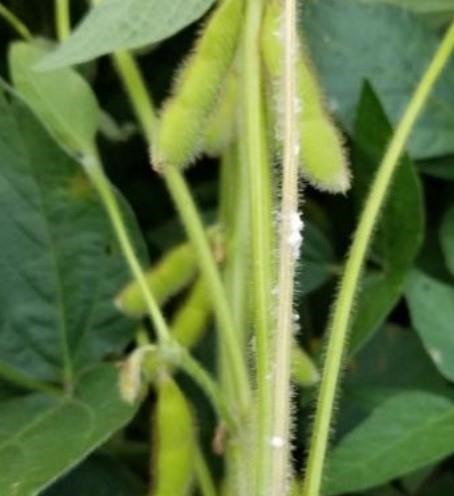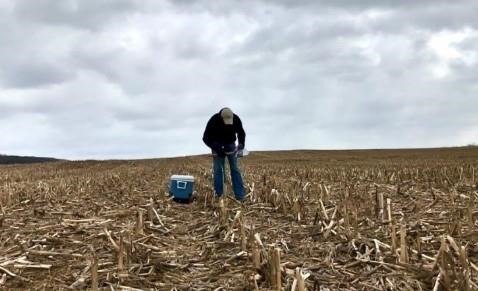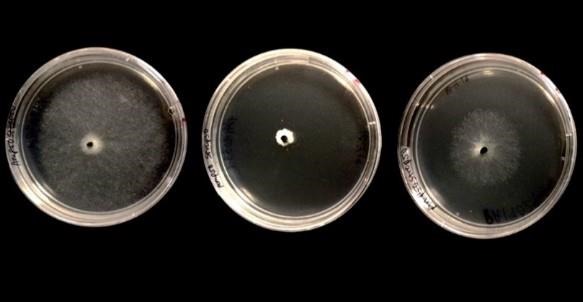By Paul D. Esker and karen Luong
White mold, caused by the fungus Sclerotinia sclerotiorum, is a disease that affects many host crops, including soybeans. This fungus thrives in cool, wet weather and infects soybeans during the flowering period. Therefore, the combination of weather at flowering, soybean variety, row spacing, and other management practices all influence white mold disease development. It is important to manage the disease to prevent spread to new areas of the state since the pathogen can survive in soil for five or more years. To improve management recommendations, our research aims to understand the pathogen distribution at both regional and field scales, validate decision-making tools like the Sporecaster app to quantify the efficacy of in-season management practices, and increase our understanding of growers’ experience with white mold disease management.

Figure 1. Symptoms of white mold in soybeans.
S. sclerotiorum Sampling
To understand the distribution and genetic diversity of S. sclerotiorum, isolates were collected at both regional and field-scales. During the spring of 2020, six fields were selected, divided into 35 plots, and soil was sampled from each quadrat. Later in the growing season, these fields were scouted for white mold and disease incidence was measured. Results were variable from field to field, but differences in the observed spatial distributions may be due to the use of tillage, fungicides, and changes in elevation. While some sclerotia were found to be aggregated in fields, in other fields, we observed the presence of white mold in sampling locations where we did not find sclerotia, indicating pathogen and disease spread to new areas. This can be attributed to ascospores traveling via wind to new locations and infecting soybean flowers. Interestingly, one field had high sclerotia density, but no disease incidence due to drought conditions during the summer, illustrating the importance of monitoring environmental conditions during the growing season, especially when soybean is in the early flowering stages. For the 2021 growing season, four additional fields will be sampled for sclerotia and work on genotyping isolates will be continued to get a better understanding of genotypic diversity at a field scale.
At the regional scale, white mold isolates were obtained from diseased soybean plants and soil samples from 19 fields across nine different counties. This summer, these isolates will be genetically analyzed to determine S. sclerotiorum diversity across Pennsylvania. Since we are also interested in increasing our knowledge of the white mold distribution in Pennsylvania and continuing to build our isolate collection, we would be very willing to collaborate with you and obtain samples from your fields. If you have a history of white mold or have diseased soybean plants, please contact Tyler McFeaters (tsm31@psu.edu), Karen Luong (kml6400@psu.edu) and we will coordinate with you to take a sample.

Figure 2. Soil sampling for sclerotia from a field (Credit: K. Luong)
Survey Results
To increase our understanding of Pennsylvania soybean growers’ disease management decision-making process and their experience with white mold, we developed survey instruments to ask attendees at virtual workshops and conferences poll questions about knowledge of white mold and which management tools they recommend or work with. We received a total of 51 responses from farmers, industry personnel, and consultants attending these virtual events. While the majority of attendees think white mold is a problem in Pennsylvania, approximately one third of respondents indicated that they did not have an issue with the disease. Approximately 42% of growers deal with white mold, with 10% having problems every year. Interestingly, one quarter of respondents indicated being uncertain about having white mold. Half of the attendees indicated that efficacy of a management practice is most considered when making decisions for disease management, whereas one quarter consider recommendations from extension educators, crop consultants, or researchers.
These survey responses suggest that white mold is an important disease that has impacted or continues to be problematic for Pennsylvania soybean growers, with the need for efficacious management strategies. Future survey work will be done to elucidate specific disease management strategies used by growers that are effective against white mold.

Figure 3. S. sclerotiorum isolates in culture. (Credit: K. Luong)
Sporecaster Validation
During the summer of 2020, 23 locations across Pennsylvania were scouted for white mold. The incidence of white mold in each field was quantified and compared to the disease risk prediction using the Sporecaster mobile application. To do this, we compared the estimated risk based on the model used in Sporecaster with the observed presence of white mold in the field at the end of the season.
One key thing that we learned in 2020 was that the weather data source used for previous versions of the app did not provide enough resolution to make the app reliable for use in Pennsylvania. Future updates of the app will integrate a new weather data source, which provides for a finer scale resolution. Furthermore, we also learned that for Pennsylvania, when deciding in season fungicide application, using a 50% threshold in the app is recommended. For detailed results of the 2020 Sporecaster validation, please see our previous article . This summer we will continuing our efforts to validate Sporecaster for the Northeast. Currently, we have at least ten locations throughout Pennsylvania that will be monitored. Through collaborations, we will also monitor sites throughout New York.
Source : psu.edu